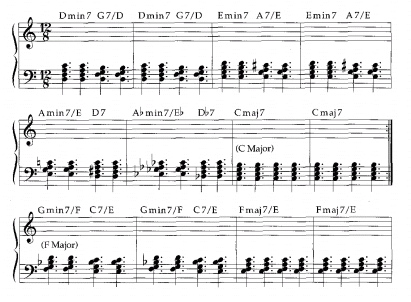The following article by Jeffrey Chappell appeared in Piano & Keyboard Magazine, July/August 1994 issue.
Start Playing Jazz in about Five Minutes
CAN YOU PLAY a C-major scale in 4/4 time? If so, you are on your way to playing jazz. Go to your keyboard and follow this exercise. Every instruction changes or adds something to what comes before it. It is important that you be secure with each step before going on to the next.
1. Tap your foot— right or left, heel or toe— in even quarter-notes, 4/4 time. Choose a comfortably moderate tempo, somewhere between 80 and 100 on the metronome.
2. With your left hand, play a C-major seventh chord on every beat.

3. With your right hand, play a C-major scale ascending and descending in eighth notes.

4. Change the rhythm in the right hand to alternating quarters and eighths in 12/8 time.

Lightly accent the eighth notes if you can do so easily; otherwise, proceed without doing so.
5. Once in awhile, whenever you feel like it, hold onto a note longer than an eighth or quarter value.

Improvisation technique: “Say as you play.” Every time you play a note in the right hand, simultaneously say a syllable such as “da.” This will reinforce your inner connection with what you play.
6. Once in awhile, whenever you feel like it, add a rest.

7. Once in awhile, whenever you feel like it, add a grace note.

8. Continue to use the notes of the C-major scale, but in any order.

Improvisation technique: Make yourself play everything twice in a row.

This will create coherence in the music as well as make you listen to and think about what you play.
Five minutes are up. You now have the hang of it. What is needed next is greater harmonic variety.
9. Use seventh chords built on white keys moving stepwise.

Improvisation technique: In the right hand, play only notes that belong to the chord in the left hand.

This is a guaranteed way to sound consonant with the harmonies.
10. Use seventh chords built on white keys, including some inversions.

This facilitates smooth voice leadings while allowing the roots of the chords to move disjunctly.
11. Alternate seventh chords in the key of C major with seventh chords in the key of D major. Use notes of the D major scale with the chords in that key.

Improvisation technique: When improvising over changes of harmony, locate the tones that are common to each succeeding pair of keys. Allowing for enharmonic spellings, any two major scales have at least two common tones. In this case, A, B, D, E, and G are common to both keys. When the harmony changes you should be playing one of those notes to avoid sounding C♯ or F♯ in C major and C or F in D major.

In fact, you can play the entire improvisation just on the common tones.

12. Use a chord progression that includes the keys of C major, D major, G major, and G♭ major. This is based on the first part of Duke Ellington’s “Satin Doll.” Start by playing the scale that matches each chord progression. The note B/C♭ is common to all four keys.

13. Improvise on the chord progression for “Satin Doll.”


14. Instead of constant quarter-notes in the left hand, include rests as well as chords that occur on offbeats.

15. Use voicings that include ninths and thirteenths while omitting the roots of the chords.

The next phase is to become fluent in all keys and to be able to move from one key to another in any order. Then you can improvise over any chord progression. Start by transposing steps 9 and 10 to all major keys.
Investigate different types of chords and the different types of scales that can be matched with them. Practice improvising on the chord progressions of standard jazz tunes. Play written transcriptions of improvisations and, most importantly, listen to jazz. This will occupy you for much longer than five minutes.
— Jeffrey Chappell
